Zambia’s beautiful Bangwelu Wetlands
The sun peeks over the horizon, turning the sky from grey to a pale pink. We stand, shivering slightly, in the early morning air. Before us, on the floodplain, are thousands of beautiful, endemic, Black Lechwe, barely visible through the thick morning mist. We’re in the Bangweulu wetlands, in north eastern Zambia. Bangweulu means “where the water meets the sky”, which is a perfect description of this extraordinary community-owned protected wetland in north-eastern Zambia. We’ve travelled here with long-time friend and professional wildlife photographer, Patrick Bentley, who is on assignment to photograph the swamps and its inhabitants. Patrick is also the reason we are here before sunrise.
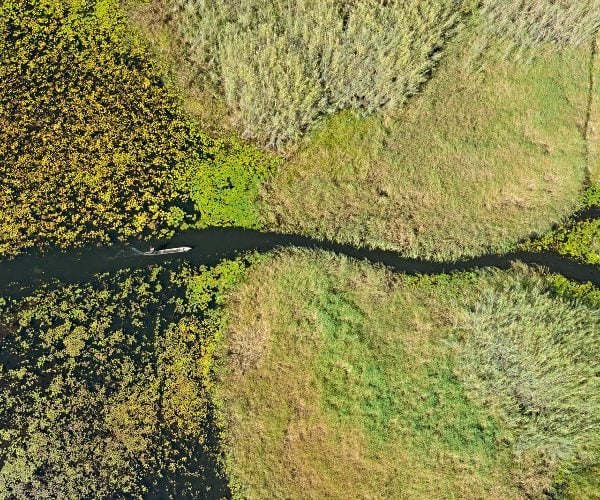
As we will learn on this trip, lighting and timing is everything to a photographer, and if that means getting up at the crack of dawn, because that is the best time to photograph something, then that’s the time we will be getting up! So here we are, it’s 6am, and we’ve been up since 5am, paddling by canoe from the lodge to the floodplains, to witness this incredible sight. Aside from the lechwe, we’ve also come to see the wetland’s other flagship species, the rare and critically endangered Shoebill and the endangered Crowned Crane.
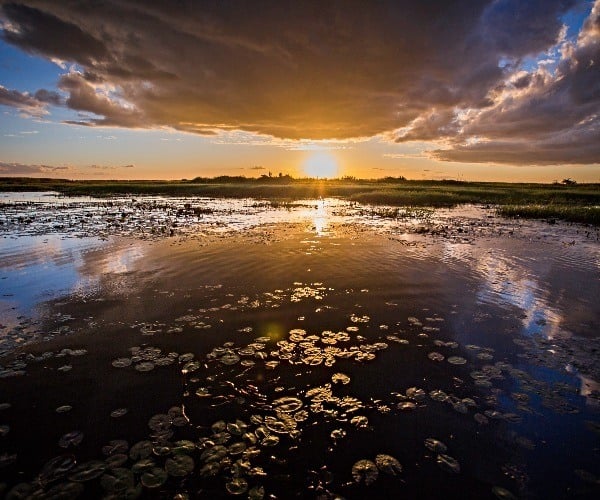
The Bangweulu swamps spreads across 6,000km2 and is an extraordinary, community-owned, protected wetland, with a rich and diverse ecosystem of floodplains, seasonally flooded grasslands, miombo woodlands and permanent swamps, all making it one of Africa’s most important wetlands. The area is home to both wildlife and to about 50,000 people. Bangweulu is unique in terms of wildlife conservation, in that it is made up of Game Management Areas, where community members are permitted to sustainably harvest natural resources.
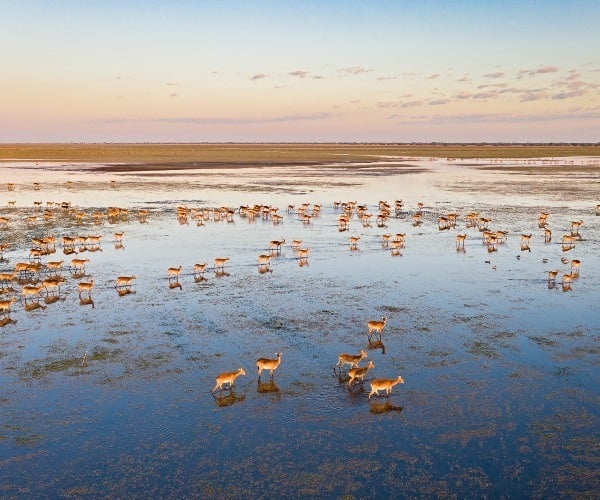
‘Sustainability’ has not always been the case though. Relentless poaching had exterminated several of the large mammal species, had decimated the black lechwe population, and had left only tiny remnant populations of buffalo, elephant and hartebeest. This over population, overfishing, and unsustainable pressure on wildlife had ultimately led the local community and the Zambian Department of National Parks and Wildlife, to enter into a long-term agreement with African Parks, to sustainably manage and protect the area’s natural resources.
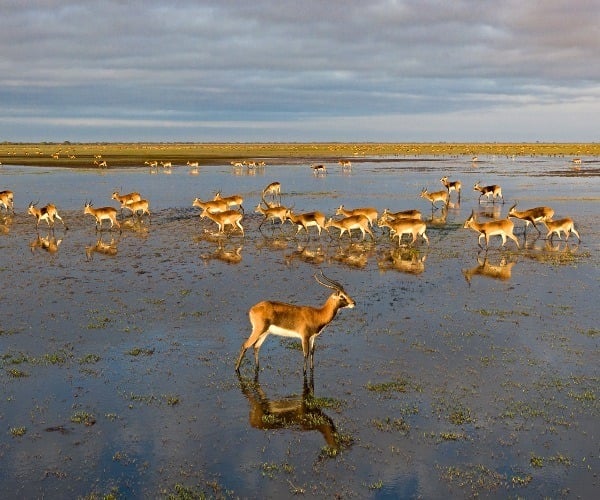
We are standing on the causeway that runs through the middle of the floodplains, there are black lechwe as far as the eye could see. As we stand and watch, thousands of them splash though the water, their hindquarters characteristically higher than their shoulders, and their elongated, spreading hooves preventing them from sinking into the swampy ground. Having come into the water overnight for safety, the lechwe are now slowly heading back towards the tree line, sometimes up to their shoulders in water, and grazing on the nutrient rich, semi-aquatic grass as they go. Once the sky is light and the lechwe have all but disappeared, it’s time to paddle the 40 minute canoe trip back to the gorgeous Shoebill Island where, nestled in a grove of Quinine trees, a late breakfast awaits.
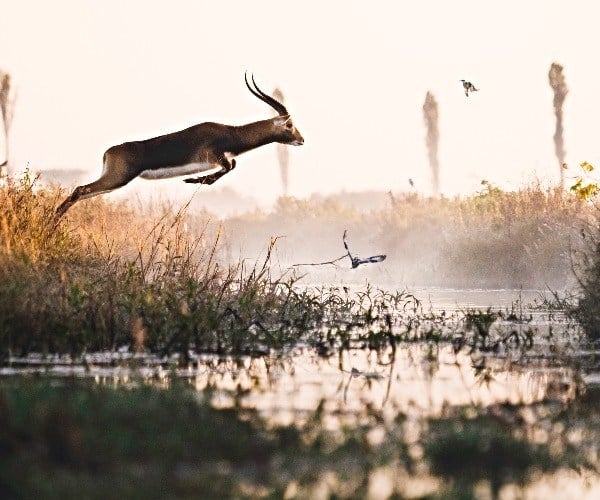
The Bangweulu wetlands are home to an abundance of birds, over 680 species are found here, and nearly all of them seemed to be out in force that morning! Kingfishers, ibis, geese, bee-eaters, terns, gulls, teals, storks, weavers, ducks, egrets, herons, bitterns and more!
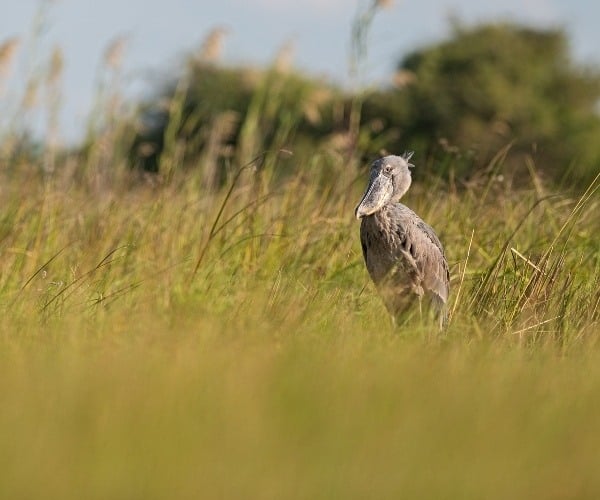
Afternoon comes and sticking with the bird theme, we go on a Shoebill ‘hunt’. Classified as vulnerable, people come from all over the world to catch a glimpse of these tall, sturdy, blue gray birds, with piercing yellowish white eyes. These prehistoric looking birds are threatened, predominantly by the illegal live bird trade, in particular the sale of chicks, for which demand seems to be increasing. The IUCN estimates global populations of Shoebills number somewhere between 3,300 and 5,300, and these numbers are decreasing. Fortunately in Bangweulu the local communities are starting to come together. Shoebills are one of the most desirable birds in Africa for birdwatchers, and the local communities recognize that they are a tourist draw of economic benefit to the community, and so they keep a watchful eye on the birds, and guard the nests to ensure chicks can fledge. The area of the Bangweulu wetlands currently protected by African Parks is home to somewhere between 300 and 500 of these birds, so seeing one was our plan for the afternoon.
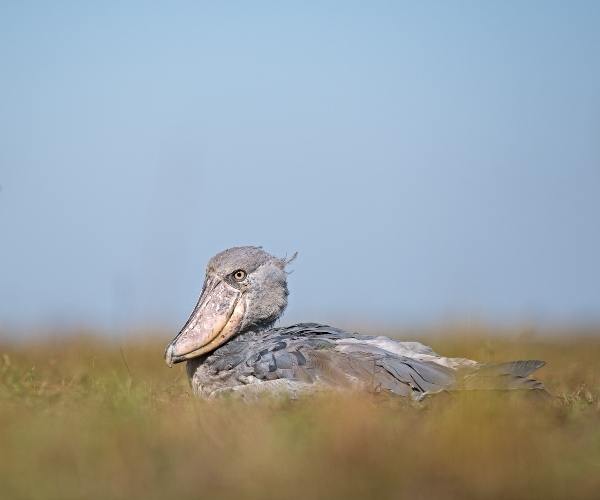
Cheating a little bit, we heard of a rescued Shoebill who, having become slightly habituated to humans, was usually fairly easy to find near a local fishing village. On our way there we are given the ‘’backstory’. Poachers having taken the baby chick from its nest and removed it from the swamps, were actively trying to sell it when they were apprehended. The chick was confiscated and returned to the wetlands, where it was nurtured by rangers until ready to release it back into the wild.
IMPORTANT NOTICE:
If you are reading this article anywhere other than on A Luxury Travel Blog, then the chances are that this content has been stolen without permission.
Please make a note of the web address above and contact A Luxury Travel Blog to advise them of this issue.
Thank you for your help in combatting content theft.
Heading to where the rescued chick had been seen last, our guide stands at the front of the canoe, long pole in hand, propelling us through narrow channels in the thick reeds and papyrus. With large numbers of people living seasonally in the swamps, we pass numerous small settlements. Music blares, children shout and play, men talk while women do the ‘chores’, something that can’t be easy, given the Spartan living conditions of the tumbledown temporary dwellings, surrounded on all sides by water. Our guide shouts to a man on the bank, he shouts back, and before we know it he’s jumped aboard our canoe. Taking the guide’s pole, he steers us towards where he’d seen the Shoebill that morning.
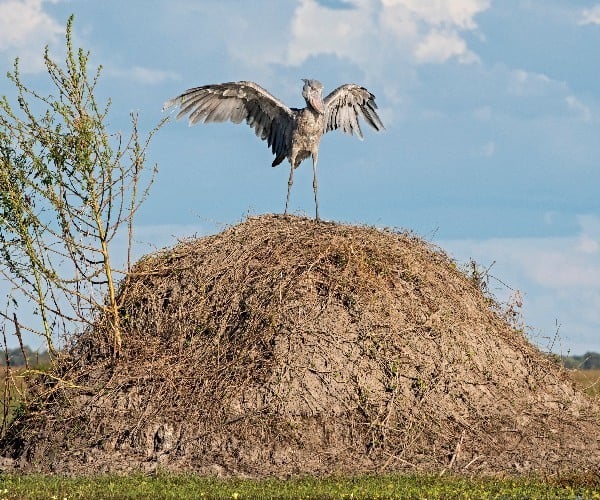
Then we see it. Lying on top of an ant-hill, on the outskirts of a fishing settlement. Anchoring our canoe at the edge of the channel, removing our shoes, we scramble overboard. Wading through knee deep water we approach the Shoebill, who casts his enormous eyes on us with a total lack of concern. We don’t approach too close, though I get the impression that, had we wanted to, we could almost have walked up and patted it on the head! In a fit of exhibitionism the Shoebill stands up, preens a little, flaps his wings experimentally, and displays some fancy footwork. Patrick gets busy with his camera. Then, exhibitionism over, the Shoebill lies down and appears to go to sleep. We splash back to the canoe and head back to camp, stopping enroute to drop off our ‘guide’.
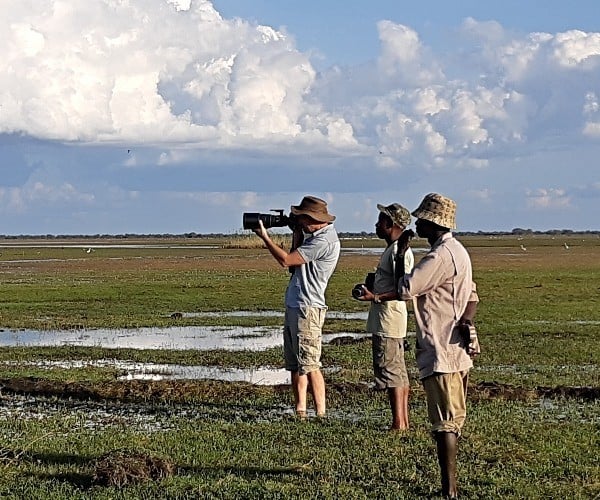
The sun sinks in the sky. Hundreds of Glossy Ibis fly out of the swamps to roost for the night, silhouetted like necklaces against the sunset. Pelicans circle overhead. We reached camp as it gets dark and sit by the fire. Millions of stars sparkle overhead and countless fire flies, glimmering like fallen stars, flit in the shadows outside the circle of firelight. After dinner we can hear hyenas in the distance.
The next morning we’re off to look for Shoebills again. Anticipating a long day of paddling and scrambling through reeds and undergrowth, we’ve packed lunch. We needn’t have bothered. Barely 20 minutes from camp, and we find our first Shoebill of the day. A little older than the one from the previous day, but equally unperturbed by our presence. He stands, watching us quizzically, looking like a child who’s raided the dress up box and chosen an outfit of old fashioned pantaloons and coat. With his large, sharp edged bill, he forages in a channel opened up by local fishermen, ready to decapitate or skewer his slippery prey. A teenage boy arrives, the ‘owner’ of the channel, and starts work repairing some nets that had been damaged by a hippo the previous evening. Only once the boy starts walking deeper into the channel, does the shoebill, with a powerful leap and a few heavy wing beats, take to the air and fly away. It’s only 8am and as we’d planned a much longer day out, we carry on paddling. Around a few more bends we find several Wattled Cranes, so spend the morning watching them instead.
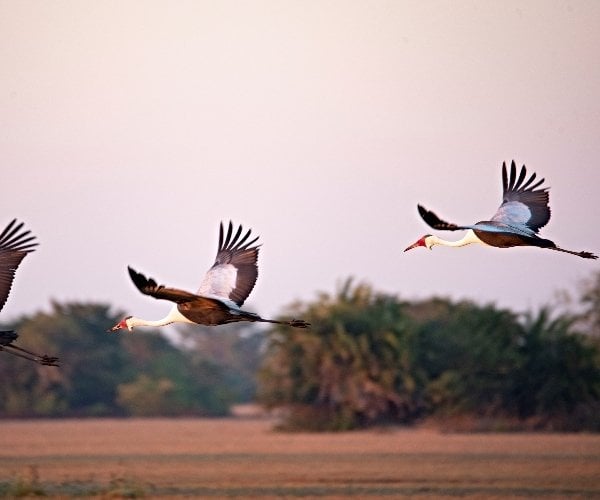
Wattled Cranes are the rarest of Africa’s crane species and numbers are in decline. The future of Wattled Cranes in Africa may well depend on Zambia. With large breeding and flocking grounds in the Bangweulu Swamps (as well as Kafue Flats, Busanga Plains and Liuwa Plains) Zambia is home to more than half of the global population of these incredible birds, with Bangweulu itself holding 10% of the world’s wattled crane population. Classified as vulnerable, with an estimated total population of 7,700 individuals. Even in Zambia, the continents stronghold, the Wattled Crane population now only stands at 4,000-4,500. The future looks a little bleak for these birds, though it was easy to forget this as we saw pair after pair of the long legged birds on our journey through the swamps.
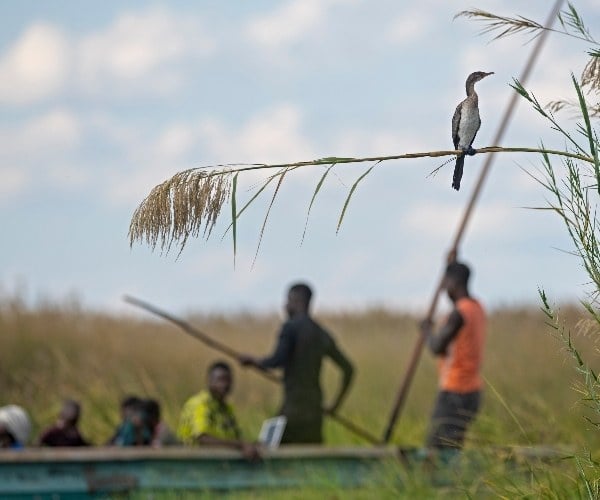
Having had such early success with our Shoebill hunt, and having had our fill of Wattled Crane watching, we took our lunch back to camp. As we ate we looked up and saw yet another Shoebill soaring overhead. That afternoon we located yet more Shoebills. The first was using its long legs and long toes to traverse the sodden marsh. We didn’t fancy negotiating the wet, floating vegetation, so paddled on. Children playing nearby shouted to get our attention, pointing out another Shoebill. We paddled closer. This one stood patiently for his photo shoot with Patrick, looking left and then looking right, as if trying to decide which his most photogenic side was! Another fantastic day in this unique wetland.
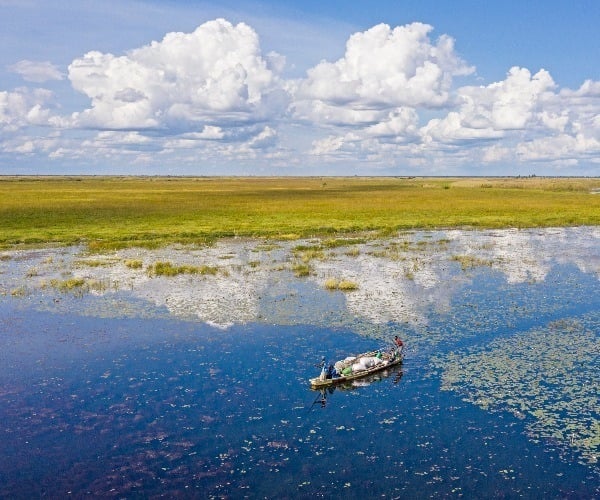
Bangweulu Wetlands is a successful model of community driven conservation, the ultimate goal being to create a workable system where both people and wildlife will benefit equally. When Africa Parks began working here overpopulation was a colossal problem. With approximately 50,000 people living legally within its boundaries, and 100,000 more living in the surrounding areas, poaching, over fishing, cutting of trees, and limited educational opportunities for local communities meant the future looked bleak. The entry of African Parks, in 2008, saw the implementation of wildlife education, reproductive health and beekeeping programs. The employment of 88 rangers, who patrol, remove snares and confiscate illegally caught fish and poached game meat, has had a positive impact on conservation. Africa Parks have successfully translocated almost 400 animals to Bangweulu, and 2020 saw the release of cheetah back into the area, with more due soon. Tourism has also been a focus, with two community camps being opened, as well as the fabulous Shoebill Camp (under management by Remote Africa Safaris).
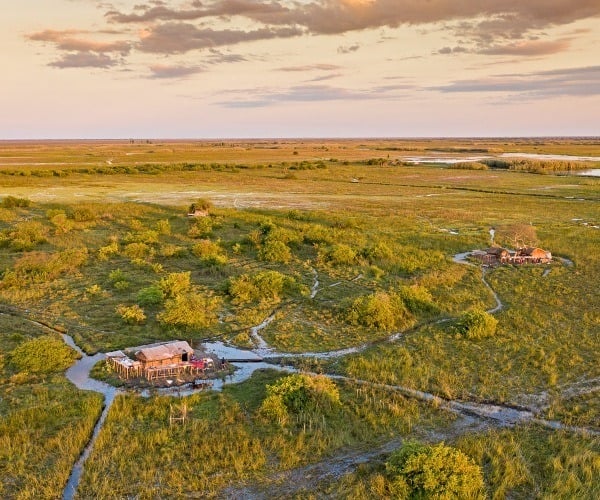
The long term sustainability of Bangweulu, one of Africa’s most extraordinary and important wetlands, will depend on continuing to build and maintain successful partnerships with the local communities; but this is without a doubt a place worth conserving, and certainly one worth visiting.
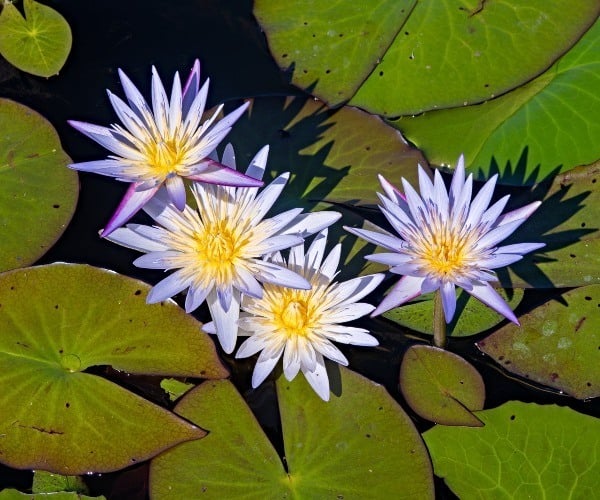
When to go
During the wet season, February – April, the park is a birdwatcher’s paradise. The plains are wet, sightings can be done by boat, and some walking is an option.
May – July, the plains are drier and the weather much cooler. This is the perfect time to see lechwe and shoebills while walking and driving in the park, opportunities for boating are dependent on the water level.
August – December is the real dry season, and during this period the conditions are ideal for game drives and camping. The dry season is also the best time to see shoebill nests.
Being just a short flight from the Luangwa Valley, the park makes an ideal day trip for those on a game safari in the valley. Guides and boats are available from February – June, and shoebill nest visits can be arranged between August – October by prior arrangement with Africa Parks.
Getting there
Bangweulu Wetlands is a long way from civilisation, the roads are not great and the journey is long, the best option is to fly. If flying there are currently two operational airstrips in the area, one grass and one gravel, and coordinates can be obtained from African Parks. Flights can be booked through Skytrails. For visitors interested in driving to the park directions can be obtained on the Bangweulu page of the African Parks website.
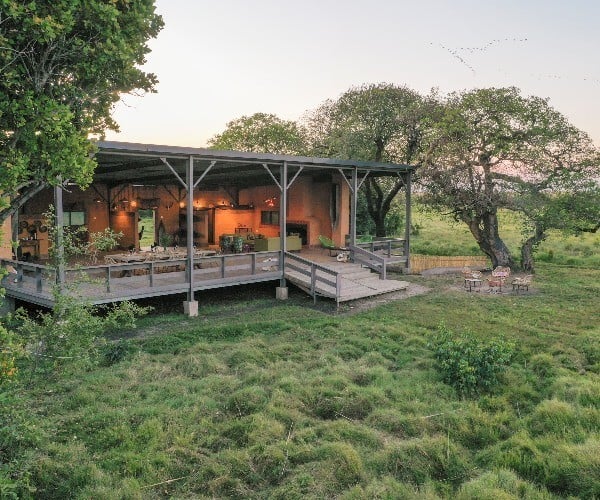
Where to stay
Africa Parks can arrange camping, homestay accommodation and accommodation at their base, you can see the details on their webpage.
For people looking for a little more luxury and comfort Remote Africa Safaris have the fabulous Shoebill Island Camp, which is in the swamps themselves, and is without a doubt the best place to stay for making the most of your experience in the wetlands.
To see some of the photographs that Patrick Bentley took from our time in the Bangweulu Wetlands, visit the Bangweulu album on his website.
Did you enjoy this article?
Receive similar content direct to your inbox.


Well worth getting up early at the crack of dawn to take fantastic pictures like these.
Francis, I agree! When I saw how well the pictures had turned out I was so pleased we’d dragged ourselves out of bed early.
Often it’s worth a little less sleep to catch those great wildlife images.
The photographer is a long time friend, he’s a professional photographer and also runs photographic safaris, I love his work (in fact he took a photo of my husband and I on this very trip, and in 25 years of marriage it’s probably one if the few photos that I like of us together!)
Sarah
A lot of us are so set in our minds on what Africa has to offer. I’d never really thought about the wetlands. They look beautiful.
Hi Craig,
You are right, there’s so much more to an African safari than just the savannah. Some of these off the beaten track destinations really reward the effort it takes to get there.
Sarah
A friend of mine grew up in Zambia (though he went to boarding school in the UK). He’s always keen to go back for holidays and is also talking about a holiday home in Zambia for when he retires. Now I can understand why.
Hi Stephan,
My husband also grew up in Zambia and went to boarding school in the UK, we’ve looked at other places to live but have always decided we like it here in Zambia too much! It’s a beautiful country with fantastic people.
Sarah
This place looks stunning. I look forward to seeing it one day.
From that top photo it’s clear that drone photography is the way to go. That’s an amazing aerial shot.
Yes Rob, drone shots are definitely the way to go to catch some of the vastness of the swamps. Drones are quite heavily controlled here and you have to get government permission/permit to use one. But it’s definitely worth the effort to capture some of the amazing scenery.
Sarah